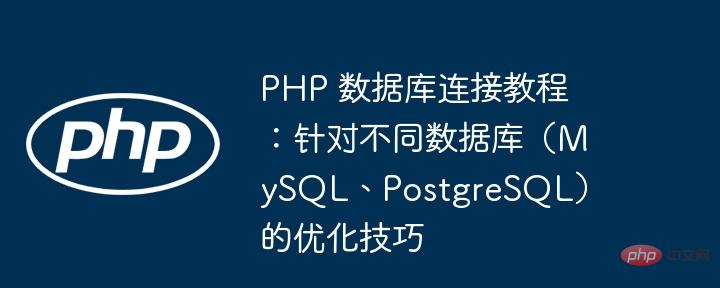Home >Backend Development >PHP Tutorial >PHP database connection tutorial: optimization skills for different databases (MySQL, PostgreSQL)
PHP database connection tutorial: optimization skills for different databases (MySQL, PostgreSQL)
- WBOYWBOYWBOYWBOYWBOYWBOYWBOYWBOYWBOYWBOYWBOYWBOYWBOriginal
- 2024-06-02 09:53:58605browse
Optimizing database connections in PHP is critical to improving application performance. MySQL connection uses MySQLi extension and uses persistent connection (pconnect()). Uses connection pool. PostgreSQL connection uses PDO extension to configure connection parameters (PDO::setAttribute())

PHP database connection tutorial: Optimization skills for different databases (MySQL, PostgreSQL)
Introduction
In PHP, establishing a connection with the database is the key to developing Web applications A crucial step in the procedure. By optimizing database connections, you can significantly improve your application's performance and scalability. This article will provide database connection optimization tips for MySQL and PostgreSQL, two commonly used databases.
MySQL connection
Using MySQLi extension
It is recommended to use the MySQLi extension of PHP because it provides better than the old MySQL extension Faster, more object-oriented approach.
$mysqli = new mysqli("localhost", "root", "password", "database");Use persistent connections
Persistent connections can reduce the overhead of creating new connections. Use the pconnect() function instead of connect() to establish a persistent connection.
$mysqli = new mysqli("localhost", "root", "password", "database", 3306, "/path/to/socket");Using connection pools
Connection pools manage a set of pre-established connections, eliminating the need to create new connections for each request. Connection pooling can be implemented using third-party libraries such as PHP PDO Connection Pool.
$config = [
'host' => 'localhost',
'user' => 'root',
'password' => 'password',
'database' => 'database',
'port' => 3306,
'maxConnections' => 10
];
$pool = new ConnectionPool($config);PostgreSQL connection
Using PDO
For PostgreSQL, it is recommended to use the PDO (PHP Data Objects) extension because it Provides an interface independent of the database engine.
$dsn = "pgsql:host=localhost;dbname=database;user=root;password=password"; $conn = new PDO($dsn);
Configuring connection parameters
You can use the PDO::setAttribute() method to configure connection parameters, such as timeout and persistent connections.
$conn->setAttribute(PDO::ATTR_TIMEOUT, 5); $conn->setAttribute(PDO::ATTR_PERSISTENT, true);
Practical case
The following is an example of using PHP to connect to a MySQL database:
$servername = "localhost";
$username = "username";
$password = "password";
$dbname = "mydb";
// 创建连接
$conn = new mysqli($servername, $username, $password, $dbname);
// 检查连接
if ($conn->connect_error) {
die("连接失败: " . $conn->connect_error);
}The above is the detailed content of PHP database connection tutorial: optimization skills for different databases (MySQL, PostgreSQL). For more information, please follow other related articles on the PHP Chinese website!

